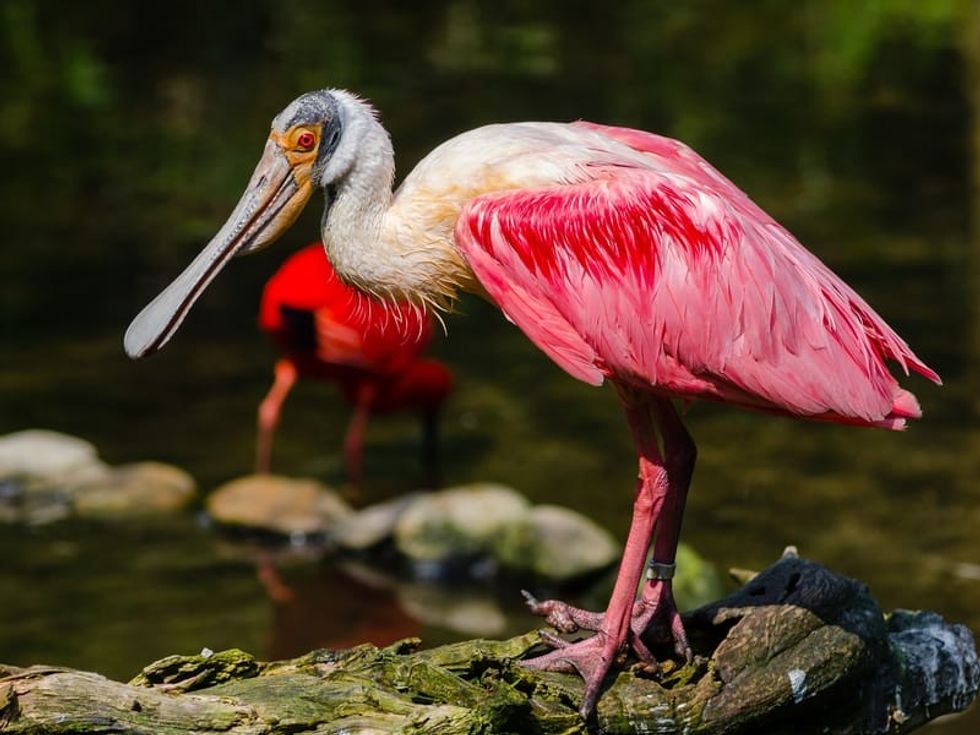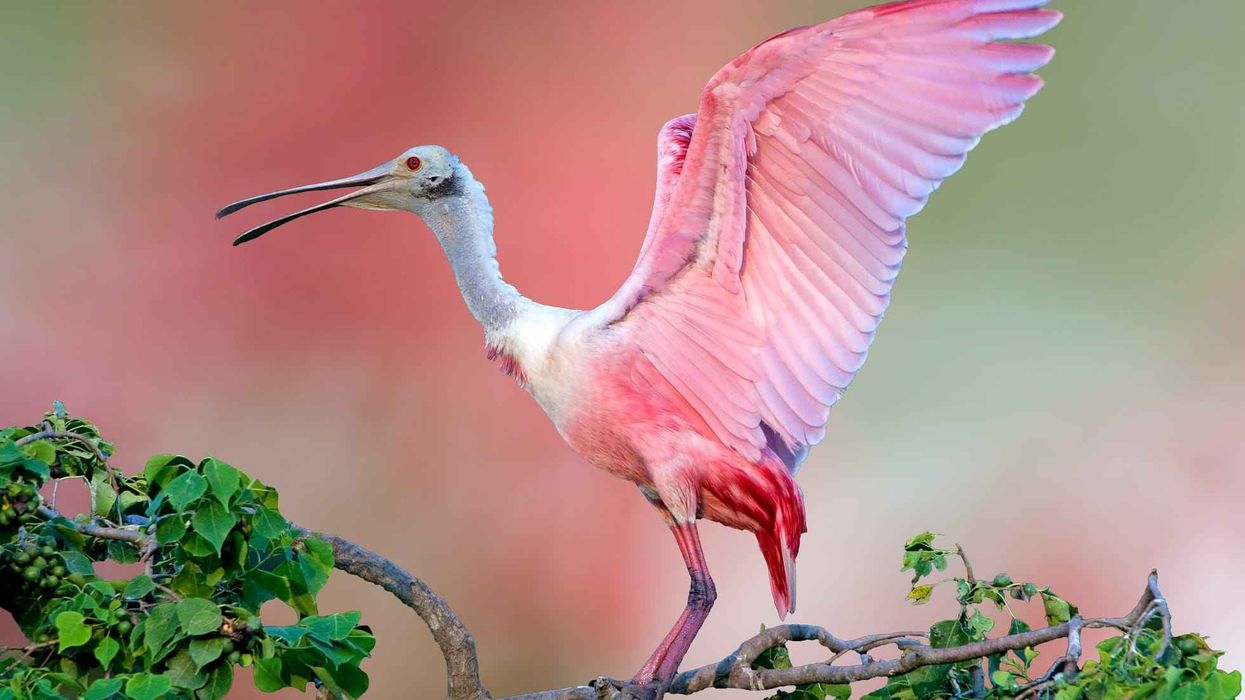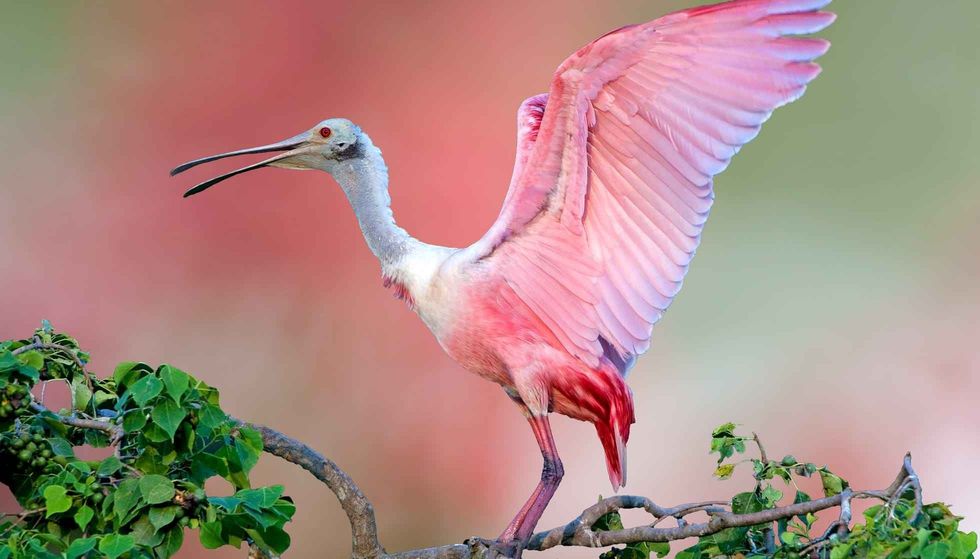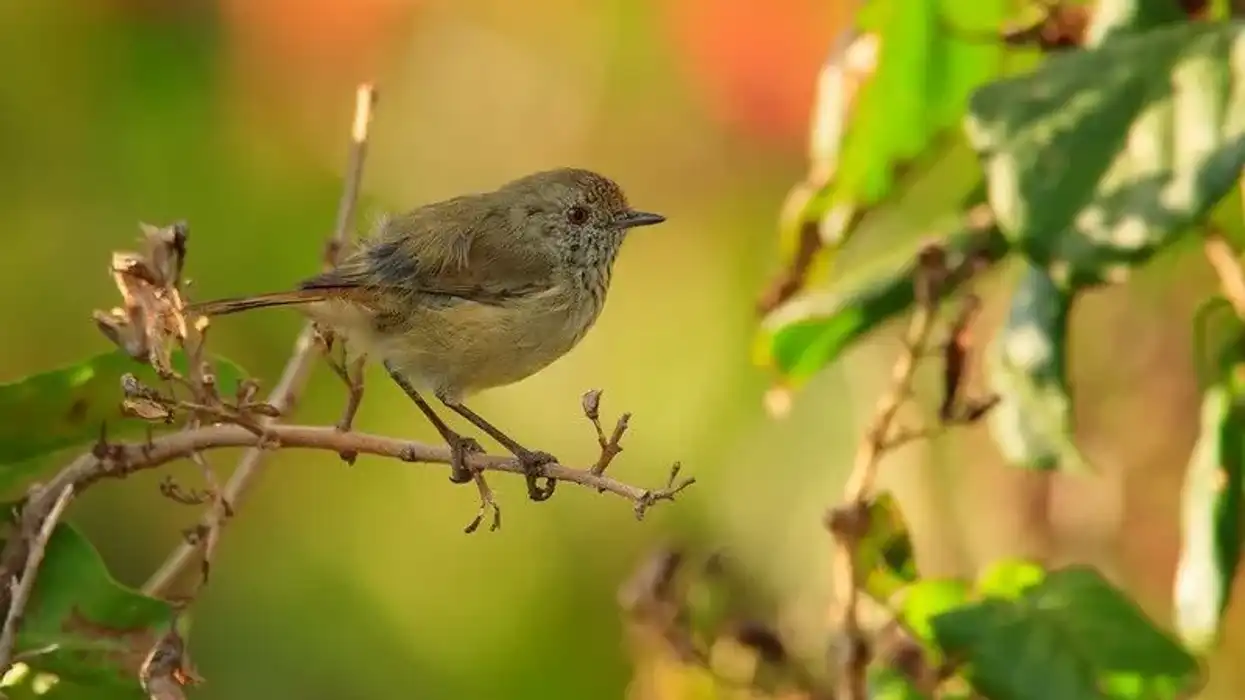Fun Roseate Spoonbill Facts For Kids

The Roseate Spoonbill (Platalea ajaja) is a large bird species found along the shorelines and the mudflats of the Gulf Coast, Central America to the tip of South America. It is one of the six spoonbill species but the only one found in the western hemisphere.
The spoon shaped or spatula-shaped beak is the unique feature that distinguishes all spoonbills from other similar wading birds. The beaks of these birds become flatter and broader like a spoon towards the end.
That allows the spoonbill roseate to scoop food out of the water conveniently.
The roseate spoonbill has pink plumage with a white upper neck and back. The wings and feathers under the upper feathers are a more distinguishable shade of light pink, the upper feathers are attention-grabbing bright pink.
A part of some of the roseate spoonbill's head is a distinct shade of yellow-green which makes the birds look even more colorful. The young birds have duller colors compared to the fully mature ones.
This species of birds are closely connected to other large wading species like the herons, egrets, and storks. It’s a misconception that the roseate spoonbills are related to flamingoes due to their pink color.
Roseate spoonbills forage wading through muddy, shallow waters of forest swamps, bays, mangroves that are less than five inches deep. They make side-way sweeps with their spoon shaped bills until they can feel the prey inside their bill.
The birds then snap open their bill and swallow the prey. They eat small crustaceans like shrimps, crayfish, prawns, crabs, small fish, and aquatic insects like slugs and mollusks.
These birds also include vegetative matters like roots and stems in their diet. Because of the bird’s eye structure, they can even forage in the dark.
You may also check out the fact files on Hawaiian crow and king penguin from Kidadl.
Roseate Spoonbill Interesting Facts
What type of animal is a roseate spoonbill?
Roseate spoonbills are a type of bird.
What class of animal does a roseate spoonbill belong to?
Rosettes belong to the spoonbill bird species. It’s the only one to be found in the western hemisphere and North and South America.
How many roseate spoonbills are there in the world?
It is difficult to gauge the exact number of roseate spoonbills but in Florida, Audubon Florida recorded 1,184 pairs. That means at least 2,368 breeding birds exist in Florida.
The roseate spoonbill population was threatened earlier by hunting, for gathering feathers to be used in hats and fans in the mid and late 1800s. These birds also faced the crisis of loss of habitat resulting from water pollution, urbanization, and drainage.
In the United States, the population of these birds in the 20th century shrunk drastically with only a few dozen nesting pairs remaining in the wild.
Realizing the danger the species faced, it was protected in the 1940s. However, the population is currently stable and roseate spoonbills no longer fall under the category of protected species.
Where does a roseate spoonbill live?
The ideal roseate spoonbill habitat is a swampy area. They live in mangrove swamps, tidal ponds, shallow bays, saltwater lagoons, and other low-lying brackish water areas.
In the United States, this bird species is found in southern Florida, southwestern Louisiana, and coastal Texas. The roseate spoonbill range extends south from Florida in North America, the Greater Antilles in the Caribbean Sea, to Argentina, Chile, and Uruguay in South America.
What is a roseate spoonbill's habitat?
Roseate spoonbills live in swampy and marshy areas like mangroves, sea-grass flats, tidal pools. The roseate spoonbill adaptations allow these birds to sift foot from muddy waters with their elongated spoon shaped bills.
Their height, thin legs allow them to lean forward and forage from the shallow waters.
In case of a shortage of food, the roseate spoonbill beak can also scoop out crustaceans and small fish from deeper water by immersing long beaks and head completely in water. Roseate spoonbills are not directly affected by the increased salinity of water and forage in areas with a variety of salt levels and even in freshwater habitats.
The range of these lovely birds with pink plumage spreads across some of the states in the USA. For roseate spoonbill Texas viewing the best time is the breeding season lasting from March to June.
According to bird guides, roseate spoonbill Louisiana sighting is best done in the Sabine National Wildlife Refuge. Roseate spoonbills prefer to live around the Gulf coast marshes and estuaries from March through October, occasionally flying inland within its range through eastern Texas. They fly towards South America during the winter.
Who do roseate spoonbills live with?
Roseate spoonbills live in flocks that typically include six or more individuals. A species of social bird, roseate spoonbills often dwell in groups while feeding, and roosting. Roseate spoonbill flying also happens in formations. While nesting, the roseate spoonbills either stay alone or in pairs, in trees close to marches, coastal islands, habitats where food is easy to find.
How long does a roseate spoonbill live?
Roseate spoonbill species can live for around ten years in the wild. Under human care, they are known to live for up to 15 years.
How do they reproduce?
Roseate spoonbills reproduce sexually. The courtship starts with aggressive behavior between the male and female bird. Later, they perch together closely, keeping the bills crossed. That’s the sign of female submission.
The process also involves a ritual of nest material exchange. During the dramatic ritual, the male may shake his head up and down in quick short motions and shake the sticks he brings to the female. The female bird may bow her head begging for nesting materials.
That includes twigs and sticks from the male. It is a way to attract and assure the female of a strong, secure deeply cupped nest. The nest is usually located in vegetation like mangroves, trees, and shrubs, on top of a water source.
Usually, a nest is always built at a height of 5-15 feet above the ground or water. Visually, the nest appears like a large platform of sticks and leaves. The male collects the materials while the female makes the nest.
They lay two or three eggs on average. However, it may range from one to five.
The white eggs with brown spots are incubated for twenty-two to twenty-four days by both the parents. When the nestlings hatch, both parents take turns to feed their young. The fledglings are ready to venture out of the nest after six to eight weeks.
What is their conservation status?
The roseate spoonbill is protected by the U.S. Migratory Bird Treaty Act and also as a Threatened species by Florida's Endangered and Threatened Species Rule. The conservation status of this species is of the least concern as the population is steadily growing under protection.
Roseate Spoonbill Fun Facts
What do roseate spoonbills look like?
Roseate spoonbills are large birds with a body covered with pink plumage and bright pink shoulder patches. Their long, thin legs are also light pink.
The neck, head, and breast are white. A part of their head bald and yellow-green. The spoon shaped bill is grey.
This species of birds do not show any significant sexual dimorphism or males and females look similar. These birds stand 28–34 in tall and have a wingspan of 47–52 in. The light and bright pink coloration of the feathers is a feature that happens due to the abundance of carotenoids and crustaceans in their diet.
No other North American bird in Florida or Texas is similar to this spoonbill species. It is the only spoonbill that is native to the Western Hemisphere and breeds in Florida.

How cute are they?
Roseate spoonbills are beautiful birds with pink feathers. A roseate spoonbill baby may not be as colorful as an adult bird.
How do they communicate?
Roseate spoonbills communicate through calls and body movements. These are comparatively silent birds and only make low noises while feeding, flying, and while breeding. Their calls are low grunting sounds. They also make sounds when startled, feeding the young birds, or greeting their mates.
How big is a roseate spoonbill?
A roseate spoonbill is more than ten times larger than a hummingbird that is three to four inches in length. A roseate spoonbill’s length can be twenty-four to thirty-two inches.
How fast can a roseate spoonbill fly?
At an altitude of 244m the roseate spoonbill can fly at a speed of 114 mph.
How much does a roseate spoonbill weigh?
Belonging to a large bird species, the roseate spoonbills weigh between 3.1–4.6 lb.
What are their male and female names of the species?
The male and the female of the roseate spoonbill species do not have any separate names. Most female birds are called hens and the males are called cocks.
What would you call a baby roseate spoonbill?
A young spoonbill is called a chick, nestling, or a fledgling like most baby birds.
What do they eat?
The roseate spoonbill diet includes small fishes, crustaceans, aquatic invertebrates, and some aquatic plants. They find their food with unique spoon shaped bills.
They sweep their bill from side to side and sift through the muddy waters hunting for their prey in shallow waters. Roseate spoonbills typically look for food in coastal marshy areas, mangroves, fresh and brackish water, lagoons, and mudflats.
Are they aggressive?
The spoonbill roseate species become aggressive during the breeding season. Males are initially very aggressive toward both male and female roseate spoonbills.
Would they make a good pet?
The roseate spoonbill is a wild bird species belonging to the family threskiornithidae, order Ciconiiformes. They cannot be kept as pets.
Once, hunting of these birds almost made the roseate spoonbill endangered. Conservation efforts by several North American states allowed this species to gain back a healthy population. Now their conservation status is not of any concern as it is stable.
Did you know...
One of the major threats that the roseate spoonbills face is the availability of food due to urbanization. The other factors are channelization of rivers and streams, reduced freshwater inflow, draining wetlands, and washed off pesticides from the fields.
When salinity exceeds the bird’s physiological tolerance they find it difficult to prey and feed on aquatic organisms. Degradation and destruction of the bird’s natural coastal foraging and nesting habitat is a major concern.
The eggs of the roseate spoonbill are more vulnerable than the young chicks. The predators of nestlings range from raccoons, coyotes, hawks, vultures, turkey, bald eagle, and also fire ants. Roseate spoonbill predators of adult birds are unheard of.
Roseate spoonbill pronunciation can be confusing. In this case, audio pronunciations can help. It sounds like ‘Roz-e-ette’. Due to its distinct features, roseate spoonbill drawing is easy and can be a good way for children to start drawing birds.
What sound does a roseate spoonbill make?
Roseate spoonbills are otherwise quite quiet birds. They make a peculiar, low, noise while feeding. In order to gain attention, they also call out during the breeding display and while they fly.
How does a roseate spoonbill fly?
Roseate spoonbills fly in long diagonal lines. While flying, their necks and legs are completely outstretched. While resting, these birds curl up their neck into an ‘S’ like shape.
Here at Kidadl, we have carefully created lots of interesting family-friendly animal facts for everyone to discover! Learn more about some other birds including greater flamingo, or least tern.
You can even occupy yourself at home by drawing one on our Roseate spoonbill coloring pages.
We Want Your Photos!
More for You
See All
Bachelor of Science specializing in Microbiology

Oluwatosin MichaelBachelor of Science specializing in Microbiology
With a Bachelor's in Microbiology from the Federal University of Agriculture, Abeokuta, Ogun State, Oluwatosin has honed his skills as an SEO content writer, editor, and growth manager. He has written articles, conducted extensive research, and optimized content for search engines. His expertise extends to leading link-building efforts and revising onboarding strategies.
Bachelor of Journalism and Mass Communication

Ankit ShindeBachelor of Journalism and Mass Communication
Ankit is a Journalism and Mass Media graduate from the University of Mumbai. With experience in SEO, blog and article writing, and fiction writing, he is a versatile writer and content creator. In his free time, Ankit enjoys reading, writing, and listening to music.
Disclaimer
1) Kidadl is independent and to make our service free to you the reader we are supported by advertising. We hope you love our recommendations for products and services! What we suggest is selected independently by the Kidadl team. If you purchase using the Buy Now button we may earn a small commission. This does not influence our choices. Prices are correct and items are available at the time the article was published but we cannot guarantee that on the time of reading. Please note that Kidadl is a participant in the Amazon Services LLC Associates Program, an affiliate advertising program designed to provide a means for sites to earn advertising fees by advertising and linking to Amazon. We also link to other websites, but are not responsible for their content.
2) At Kidadl, we strive to recommend the very best activities and events. We will always aim to give you accurate information at the date of publication - however, information does change, so it’s important you do your own research, double-check and make the decision that is right for your family. We recognise that not all activities and ideas are appropriate for all children and families or in all circumstances. Our recommended activities are based on age but these are a guide. We recommend that these ideas are used as inspiration, that ideas are undertaken with appropriate adult supervision, and that each adult uses their own discretion and knowledge of their children to consider the safety and suitability. Kidadl cannot accept liability for the execution of these ideas, and parental supervision is advised at all times, as safety is paramount. Anyone using the information provided by Kidadl does so at their own risk and we can not accept liability if things go wrong.
3) Because we are an educational resource, we have quotes and facts about a range of historical and modern figures. We do not endorse the actions of or rhetoric of all the people included in these collections, but we think they are important for growing minds to learn about under the guidance of parents or guardians.







